Why is DC energy metering important?
In the 21st century, governments around the world are developing action plans to address the long and complex challenge of reducing CO2 emissions. CO2 emissions have proven to be a serious contributor to climate change, while the need for new and efficient energy conversion technologies and improved battery chemistries is rapidly growing.
Including renewable and non-renewable energy sources, the world population consumed nearly 18 trillion kWh last year alone, and this demand continues to grow; in fact, over the past 15 years, more than half of that of existing energy.
To that end, our grids and generators continue to grow; today, there is an ever-increasing need for more efficient and greener energy sources. Early grid developers used alternating current (ac) to power the world because it was easier to use, but in many regions direct current (dc) offers significant efficiency gains.
Driven by the development of efficient and economical power conversion technologies based on wide-bandgap semiconductors such as GaN and SiC devices, many applications are now seeing the benefits of conversion to DC power. Therefore, accurate DC energy metering is becoming more and more important, especially when it comes to energy billing. This article will discuss the development opportunities of DC metering in electric vehicle charging stations, renewable energy generation, server farms, microgrids, and peer-to-peer energy sharing, and introduce a DC meter design.
DC energy metering applications
Electric Vehicle DC Charging Station
Plug-in electric vehicles (EVs) are projected to grow at a CAGR of +70% through 2018 and are expected to grow at a CAGR of +25% from 2017 to 2024. The charging station market will grow at a CAGR of 41.8% from 2018 to 2023. However, in order to accelerate the reduction of CO2 emissions from private transportation, electric vehicle demand is the first choice in the automotive market.
In recent years, a lot of work has been done to increase battery capacity and service life, but at the same time it is necessary to provide an extensive electric vehicle charging network so that long-distance travel can be achieved without worrying about driving range or charging time. Many energy providers and private companies are deploying fast chargers up to 150 kW, and ultrafast chargers with power up to 500 kW per charging pile have also sparked public interest. Considering ultra-fast charging stations with local charging peak powers of up to megawatts and the associated fast-charging energy premium rates, EV charging will become a huge power exchange market, with the consequent need for accurate power billing.
Currently, standard EV chargers are metered on the AC side, with the disadvantage of not being able to measure the power lost during the AC-DC conversion process, so the billing is inaccurate for the end customer. Since 2019, new EU regulations have required energy providers to only charge customers for the electricity delivered to electric vehicles, leaving both power conversion and distribution losses borne by the energy provider.
While advanced SiC EV converters can achieve efficiencies of over 97%, when fast and ultrafast chargers are connected directly to the car battery, the power is delivered in DC, in which case it is clear that accurate metering on the DC side is required. fee. In addition to the public interest involved in EV charging metering, private and residential point-to-point EV charging schemes may have greater incentives for accurate energy billing on the DC side. 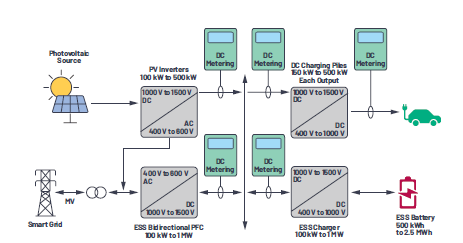 Figure 1. DC energy metering for future EV charging stations
Figure 1. DC energy metering for future EV charging stations
 Figure 2. DC energy metering for sustainable microgrid infrastructure
Figure 2. DC energy metering for sustainable microgrid infrastructure
DC Power Distribution – Microgrid
What is a microgrid? Essentially, a microgrid is a smaller version of a utility power system. Therefore, there is a need for safe, reliable, and efficient power supplies. Microgrids may be used in hospitals, military bases, or even as part of a utility system, where renewable energy generation, fuel generators, and energy storage work together to form a reliable energy distribution system.
Microgrids are also used in building construction. With the widespread use of renewable energy generators, buildings can even power themselves, with rooftop solar panels and small wind turbines generating enough electricity to operate independently but still provide public grid support.
In addition, up to 50% of the electrical load in the building is direct current. Currently, every Electronic device must convert alternating current to direct current, losing up to 20% of its electrical energy in the process, with an estimated total energy savings of up to 28% compared to traditional AC power distribution.
In buildings where direct current is deployed, energy consumption can be reduced by converting alternating current to direct current once and feeding the direct current directly into required equipment such as LED lights and computers.
With the growing interest in DC microgrids, the need for standardization is increasing.
IEC 62053-41 is an upcoming standard that will specify requirements and nominal levels for residential DC systems and enclosed meters (equivalent AC metering similar to DC energy metering).
As of 2017, the DC microgrid segment is worth about $7 billion and will grow further with the emerging trend of DC distribution.
DC powered data center
Data center operators are actively considering different technologies and solutions to improve the electrical efficiency of their facilities, as electricity is one of their biggest costs.
Data center operators see the associated benefits of DC power distribution, which not only reduces the minimum number of conversions that need to be made between AC and DC, but also makes integration with renewable energy easier and more efficient. The reduction in the transformation series is estimated as:
– 5% to 25% energy savings: improve transmission and conversion efficiency, and reduce heat generation
– Double reliability and availability
– 33% less floor space
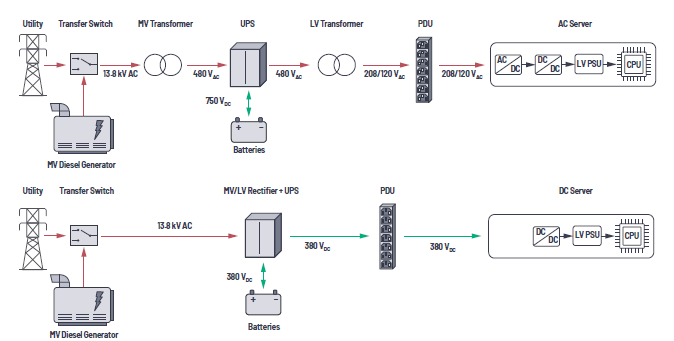 Figure 3. Compared to traditional AC power distribution, DC power supply in a data center requires fewer components and lower losses
Figure 3. Compared to traditional AC power distribution, DC power supply in a data center requires fewer components and lower losses
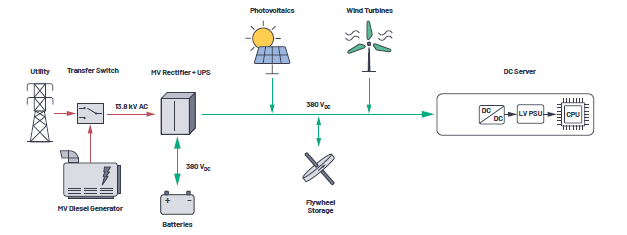 Figure 4. Renewable Energy Integration in DC-Powered Data Centers
Figure 4. Renewable Energy Integration in DC-Powered Data Centers
With distribution bus voltages ranging up to around 380 VDC, accurate DC energy metering is gaining more and more attention as many operators begin to charge their colocation customers for metered usage.
There are two common ways to bill hosting customers for electricity:
– Every time (fixed fee per exit)
– Electricity consumed (metered outlet – electricity bill charged for each kWh consumed)
To encourage greater power efficiency, metered output methods are gaining popularity, and customer pricing involves the following components:
Recurring cost = space cost + (IT equipment meter reading × PUE)
– Space fee: fixed, including security and all building operating costs
– IT equipment meter reading: kWh consumed by IT equipment multiplied by electricity cost
– Power Usage Effectiveness (PUE): Consider the efficiency of the infrastructure behind IT, such as cooling
A typical modern rack will consume up to 40 kW of DC power. Therefore, billing grade DC meters are required to monitor currents up to 100 A.
Precision DC Energy Metering Challenges
In the early 20th century, traditional AC meters were entirely electromechanical. Eddy currents are induced in a rotating aluminum disk using a combination of voltage and current coils. The torque developed on the aluminum disk is proportional to the product of the voltage and the magnetic flux produced by the current coil. Finally, a crushing magnet is added to the aluminum disc to make the rotational speed proportional to the actual power consumed by the load. At this point, the power consumption can be measured simply by counting the number of rotations over a period of time.
Modern AC meters are more sophisticated, more accurate, and prevent electricity theft. Advanced smart meters can now even monitor their absolute accuracy and detect signs of electricity theft 24/7 when installed in the field. ADI’s ADE9153B metering IC has this capability, which uses mSure technology.
Whether modern, traditional, AC, or DC, meters are classified according to their pulse-per-kWh constant and percent-grade accuracy. The number of pulses per kWh represents the energy update rate, or resolution. Class accuracy represents the maximum metering error of electrical energy.
Similar to older mechanical meters, the energy in a given time interval is measured by counting these pulses; the higher the pulse frequency, the higher the instantaneous power, and vice versa.
DC Meter Architecture
The basic architecture of the DC meter is shown in Figure 5. To measure the power dissipated by the load (P = V × I), at least one current sensor and one voltage sensor are required. When the low voltage side is at ground potential, the current flowing through the meter is usually measured on the high voltage side to minimize the risk of unmetered leakage, but current can also be measured on the low voltage side or on both sides if the design architecture requires it Measurement. A technique that measures and compares the current on both sides of the load is often used to enable the meter to have fault and tamper detection capabilities. However, when measuring current on both sides, at least one current sensor needs to be isolated in order to handle high potentials between conductors.
Voltage measurement
Voltage is usually measured with a resistive divider, where a ladder resistor is used to scale down the potential to a level compatible with the system ADC input.
Due to the large amplitude of the input signal, accurate voltage measurements are easily achieved using standard components. However, care must be taken with the temperature and voltage coefficients of the selected components to ensure the required accuracy over the entire temperature range.
As mentioned earlier, DC meters used in applications such as electric vehicle charging stations sometimes require dedicated billing for the energy delivered to the vehicle. To meet measurement requirements, a DC meter for EV chargers may need to have multiple voltage channels, allowing the meter to also detect voltage at the vehicle’s entry point (4-wire measurement). With DC energy metering in a 4-wire configuration, it is possible to deduct all resistive losses from charging piles and cables from the total energy bill.
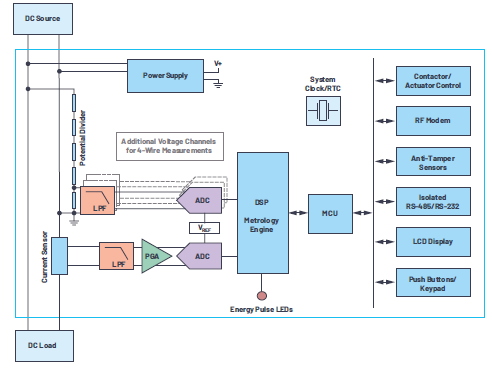 Figure 5. DC Meter System Architecture
Figure 5. DC Meter System Architecture
Current measurement for DC energy metering
Current can be measured by direct connection or indirectly by inducing the magnetic field generated by the flow of charge carriers. The next section will discuss the most commonly used DC current measurement sensors.
Shunt resistor
Direct-connect current sensing is a proven and reliable method of measuring AC and DC currents. Current flows through a shunt resistor of known resistance. According to Ohm’s Law (V = R × I), the voltage drop across a shunt resistor is proportional to the current flowing through the resistor. Amplify and digitize the voltage drop to accurately determine the current in the circuit.
Shunt resistance sensing is an accurate, efficient, low-cost method suitable for measuring mA to kA currents with theoretically unlimited bandwidth. However, this approach has some drawbacks.
When current flows through a resistor, the Joule heat generated is proportional to the square of the current. Not only does this result in a loss of efficiency, but self-heating effects can also affect the shunt resistance value, resulting in a loss of accuracy. To limit self-heating effects, low value resistors can be used. However, with small resistors, the voltage across the sensing element is also small, sometimes comparable to the DC offset of the system. In these cases, it is not easy to achieve the desired accuracy at the low end of the dynamic range. An advanced analog front end with ultra-low DC offset and ultra-low temperature drift can be used to overcome the limitations of low value shunt resistors. However, since the op amp has a constant gain-bandwidth product, high gain will limit the available bandwidth.
Low-value current sense shunts are typically fabricated from specific metal alloys, such as manganese-copper or nickel-chromium, which can counteract the reverse temperature drift of their individual components, resulting in a total drift of about tens of ppm/°C.
Another error factor in direct-connect DC measurements is the thermoelectromotive force (EMF) phenomenon, also known as the Seebeck effect. In the Seebeck effect, a temperature difference between at least two different electrical conductors or semiconductors forming a junction creates a potential difference between the two. The Seebeck effect is a well-known phenomenon that is widely used to detect the temperature of thermocouples.
In a 4-wire connected shunt, Joule heating will form in the center of the resistive alloy element, propagating along with the copper sense wires, which may be connected to the PCB (or other medium) and may also have different temperatures.
The sensing circuit will form a symmetrical distribution of different materials; therefore, the junction potentials on the positive and negative sense wires will be approximately canceled. However, any difference in thermal capacity, such as the negative sense wire connected to a larger copper block (ground plane), can cause a mismatch in temperature distribution, which can cause measurement errors due to thermo-EMF effects.
Therefore, attention must be paid to the connection of the shunt and the distribution of the heat generated.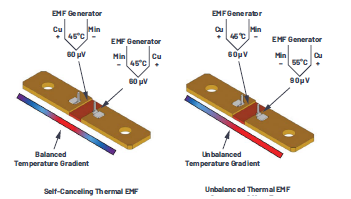 Figure 6. Thermoelectromotive force in shunt due to temperature gradient
Figure 6. Thermoelectromotive force in shunt due to temperature gradient
Magnetic Field Induction – Indirect Current Measurement
Open loop Hall effect
The sensor consists of a high permeability ring through which the induced current wire is passed. This concentrates the magnetic field lines around the conductor under test onto a Hall-effect sensor that is inserted within the cross-section of the magnetic core. The output of this sensor is preprocessed and is usually available in different configurations. The most common are: 0 V to 5 V, 4 mA to 20 mA, or digital interface. Absolute accuracy is typically no less than 1% while providing isolation and high current range at relatively low cost.
Closed Loop Hall Effect
A multi-turn secondary winding on the flux core driven by the current amplifier provides negative feedback to achieve zero total flux. By measuring the compensation current, linearity is improved, there is no core hysteresis, overall excellent temperature drift, and higher accuracy than open-loop solutions. The typical error range drops to 0.5%, but additional compensation circuitry makes the sensor more expensive and sometimes bandwidth limited.
fluxgate
is a complex open-loop or closed-loop system that measures current by monitoring flux changes in intentionally saturated magnetic cores. The coils are wound on a high permeability ferromagnetic core that is intentionally saturated by a secondary coil driven by a symmetrical square wave voltage. Whenever the core approaches positive and negative saturation, the coil’s inductance collapses and its current rate of change increases. The current waveform of the coil remains symmetrical unless an external magnetic field is applied, which makes the waveform asymmetrical. By measuring the magnitude of this asymmetry, it is possible to estimate the strength of the external magnetic field, and the resulting current. It can provide good temperature stability and 0.1% accuracy. However, the complex electronics in the sensor make it an expensive solution, 10 times more expensive than other isolated solutions.
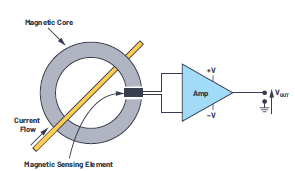 Figure 7. Open-loop current sensor based on flux concentrator and magnetic sensor
Figure 7. Open-loop current sensor based on flux concentrator and magnetic sensor
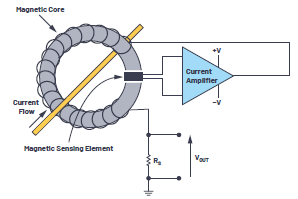 Figure 8. Example of how a closed-loop current sensor works
Figure 8. Example of how a closed-loop current sensor works
DC Energy Metering: Requirements and Standardization
While standardization of DC energy metering may seem easy compared to the existing ecosystem of AC metering standards, industry stakeholders are still discussing the requirements for different applications, which will require more time to finalize the specifics of DC metering.
IEC is developing IEC 62053-41 to define specific requirements for active energy DC electrostatic meters with accuracy classes of 0.5% and 1%.
The standard proposes a range of nominal voltages and currents and imposes limits on the maximum power consumption of the voltage and current channels of the meter. In addition, as with the AC metering requirements, specific accuracy over the dynamic range is defined, as well as the current threshold under no-load conditions.
The draft has no specific requirements for system bandwidth, but requires successful completion of rapid load change tests, and defines implicit requirements for minimum system bandwidth.
DC metering in electric vehicle charging applications sometimes conforms to the German standard VDE-AR-E 2418 or the old railway standard EN 50463-2. Accuracy is specified for each sensor according to EN 50463-2, the combined energy error is the quadrature sum of voltage, current and calculated error:
Table 1. Maximum Current Error Percentage According to EN 50463-2 Standard
| Current range | 0.2R class | 0.5R class | Class 1R |
| 1% to 5% IN | 1% | 2.5% | 5% |
| 5% to 10% IN | 0.4% | 0.5% | 1% |
| 10% to 120% IN | 0.2% | 0.5% | 1% |
Table 2. Maximum voltage error percentage according to EN 50463-2
| voltage range | 0.2R class | 0.5R class | Class 1R |
| <66%VN | 0.4% | 1% | 2% |
| 66% to 130% VN | 0.2% | 0.5% | 1% |
Conclusion: Proof of Concept Compliant DC Meter
Analog Devices is an industry leader in precision sensing technology, providing complete signal chains for precision current and voltage measurements to meet stringent standards. The next section presents a proof-of-concept for a DC energy meter compliant with the requirements of the forthcoming specific standard IEC 62053-41.
Considering the space available for bill-level DC energy metering in microgrids and data centers, we can assume the demands shown in Table 3.Table 3. DC Meter Specifications – Proof of Concept
| Rated value | Nominal value | Dynamic Range | Measurement (Max Range) |
| Voltage | ±400VDC | 100:1 | ±600V |
| current | ±80A | 100:1 | ±240A |
| precision | 1% to 5% INOM | 1% | |
| 5% to 120% INOM | 0.5% | ||
| temperature | -25°C to +55°C | -40°C to +70°C storage | |
| Meter constant | 1000 imp/kWh | ||
| Voltage and current bandwidth | 2.5kHz |
Accurate low-cost current sensing (<1 μvemf>
A commercial 75 μΩ shunt will keep power dissipation below 0.5 W.
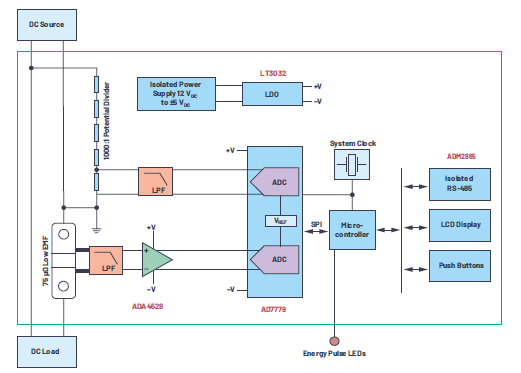 Figure 9. DC Meter System Architecture
Figure 9. DC Meter System Architecture
However, on a 75 μΩ shunt, 1% of the 80 A nominal current produces a small signal of 60 μV, requiring the use of a signal chain in the sub-microvolt offset drift performance range.
With a maximum offset voltage of 2.5 μV and a maximum offset voltage drift of 0.015 μV/°C, the ADA4528 is ideal for ultra-low drift, 100 V/V amplification for small shunt signals. Therefore, the AD7779, a simultaneous sampling, 24-bit ADC, can be connected directly to the amplifier stage with 5 nV/°C input-referenced offset drift.
Figure 10. Proof of Concept – Prototyping
High DC voltages can be accurately measured with a 1000:1 ratio resistive potential divider connected directly to the AD7779 ADC input.
Finally, a simple sample-by-sample, interrupt-driven metering function is implemented using a microcontroller, where for each ADC sample, the interrupt routine is:
– Read voltage and current samples
– Calculate instantaneous power (P = I × V)
– Accumulate instantaneous power in the energy accumulator
– Check if the energy accumulator exceeds the energy threshold to generate energy pulses and clear the energy accumulation register
Furthermore, in addition to metering functions, the microcontroller supports system level interfaces such as RS-485, LCD Display and push buttons.

0 Comments for “Why is DC energy metering important and how to design a DC meter better?”